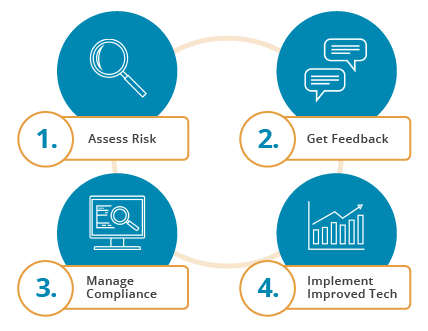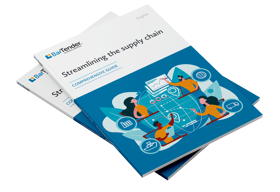Establishing supply chain visibility is a requirement for enterprise organizations who seek to establish trust with their partners, consumers, and meet the growing demands of regulatory standards. Achieving a high level of supply chain transparency gives organizations insight into how they can work more efficiently, accurately and improve workflows and processes.
Yet, a lack of visibility is an ongoing challenge, especially as organizations scale and grow. A 2017 supply chain survey showed that just 6 percent of firms surveyed felt they had complete supply chain visibility, while 77 percent said they had no visibility or a limited view. With so little visibility, disruptions may occur or frustrations may develop with partners, leading to inefficiencies that affect stakeholders at every level.
The foundation of proper visibility is supply chain traceability, which involves secure, reliable, real-time data of all products as they travel through the supply chain. Choosing the right barcode and labeling software that creates interoperability allows for a single source of data management that’s trustworthy and enhances traceability.
With a need for greater visibility, it’s more important than ever for organizations to understand the value that accurate labeling brings to their supply chain. This article takes an in-depth look at components of supply chain visibility, including transparency, traceability and mapping, and the immense benefits of implementing effective labeling solutions.
What is supply chain visibility?
Supply chain visibility is about offering insight into what and where a given product is at any point in the supply chain. This involves transparency across the organizations and its partners including manufacturers, vendors, warehouses, logistics and distribution centers. Ultimately, complete visibility leads to more efficient management of increasingly complex supply chains, credibility with consumers and compliance with changing regulatory guidelines.
Visibility is important for both your organization’s internal operations and to better align with your partners. While every stakeholder may have their own digitized systems in place, if they don’t connect and integrate, that can lead to costly discrepancies.
There is an immense amount of data to be captured, which is often siloed making it hard to access necessary information. This data often includes:
- Data from warehouse management systems (WMS)
- Database files
- Spreadsheets
- Clocks
- Scales
- Regulatory information
- Status reports
- Delivery details
Creating a standardized labeling system is one way for enterprise organizations to integrate data into one place, making it easier for every stakeholder to understand and track the product, and thus improve supply chain management.
One way to implement an effective labeling system and enhance interoperability is through GS1 standards that create a common language for stakeholders within the supply chain. This language helps “identify, capture and share supply chain data,” which ensures accuracy and reliability.
GS1 standards go a step further to enhance visibility with GS1 Digital Link. These GS1 barcodes offer contextual data to end users according to their location, time zone, demographics or campaign. This enhances item-level identification, which can lead to more accurate traceability and fewer errors in the supply chain.
For example, a logistics provider may have their own system of tracking products within their facilities. But once that product enters another facility, it can be difficult to track in another system. This is where interoperability with multiple systems is key. With a GS1 barcode, a logistics provider has total visibility and can get real-time information about a specific product and manage its entire journey, even when it’s outside of their facility.

What is supply chain transparency?
Supply chain transparency is focused on the commitment between stakeholders to disclose information that’s relevant and useful to their supply chain. Depending on the industry, transparency may include data sharing with consumers, regulatory agencies, prospective clients or other organizations within the supply chain.
While there is crossover between visibility and transparency, the focus of transparency is to create accountability and credibility with stakeholders through disclosure of information. Transparency ensures the manufacturing of quality products, compliance, safety and accuracy because organizations understand their responsibility to provide information.
Over time, this can help enterprise organizations secure and maintain valuable partnerships and increase consumer confidence. In a study by MIT Sloan School of Management, they found that consumers may be willing to pay 2% to 10% more for products when there is more supply chain transparency.
Examples of supply chain transparency may include everything about a product as it moves from the manufacture to its point-of-use, including:
- Ingredients a product contains
- Temperatures a product is subjected to
- Who has handled the product
- How long it’s been in transition from one point to another
- Work conditions
- Product/component origins
- Labor practices
Transparency is so important that many regulatory agencies have enacted guidelines to encourage the consistent, reliable sharing of information and proper conduct.
An example is in the food and beverage sector where the US FDA established the Food Safety Modernization Act (FSMA). The FSMA is aimed at preventing foodborne illness by creating a set of standards to be followed at each point in the global supply chain while requiring more disclosure about food handling practices, production, transport and sources. In essence, the FSMA is creating a framework for more transparency, which ultimately benefits every stakeholder.
What is supply chain traceability?
Supply chain traceability is the accurate, real-time tracking of parts, components and products as they travel from the manufacturer to end user, in addition to each product’s origin and final destination. Each step of the production and distribution process is traced and monitored to provide better supply chain visibility, improve quality control and prevent risks to consumers.
As more enterprise organizations go global, the complexities of traceability increase, making it even more essential to implement enterprise business labeling software that can accurately trace products at every point. Traceability is especially important in regulated industries, like food and pharmaceuticals, where complete accuracy is required to meet standards and provide safe products.
Traceability plays an integral role in sustainability as well, helping regulatory agencies decipher products that are sourced sustainably from those that are not.
For example the seafood supply chain is rife with unauthorized fishing practices that are leading to overexploitation in some parts of the world like Indonesia, who supplies 27% of U.S. frozen tuna. By tracing the tuna from the boat in Indonesia to the store in the U.S., regulatory agencies can encourage more sustainable practices that also promote safer products. Labeling compliance and regulations can improve traceability and ultimately supply chain visibility.
What is supply chain mapping?
Mapping is how organizations track and visualize how their products move through the supply chain, which ultimately leads to better visibility. By mapping and analyzing ahead of time, organizations can avoid unnecessary confusion and delays while achieving desired outcomes because they know every site, product and supplier in their supply chain. Thorough mapping may include information about:
- Manufacturing
- Origin sourcing
- Compliance
- Transportation/logistics
- Critical business functions
Benefits of supply chain visibility
Supply chain optimization can lead to cost-effective solutions for your organization and help you prevent problems, but if you can’t first visualize your supply chain, you won’t be able to reap those benefits, and the many others that stem from more visibility, such as:
- Balance supply and demand
- Promptly respond to disruptions in supply chain
- Improve organization workflows and processes
- Establish good working relationships with partners
- Manage suppliers
- Improve customer satisfaction
- Enhance safety
- Make real-time adjustments
- Ensure compliance across entire supply chain
Part of improving visibility is implementing a strategic and comprehensive labeling system that allows you to accurately track products at every point, which is especially important for labeling compliance. It’s key to choose barcode and labeling software that has the ability to scale with your business and evolving international regulations. Adding in this layer of compliance creates:
- Interoperability with trading partners for compliance across supply chain
- Efficient global labeling system
- Reduced redundancies in labeling
- Increased inventory visibility through smart labeling
- Seamless change management as business grows
- Compliance with GS1, EPCglobal’s Gen 2 standard (ISO 18000-6C), and more
- Serialization management that creates more supply chain transparency
What does a visible supply chain look like?
Visibility may look slightly different depending on the industry and the intricacies of a particular supply chain. Yet, the concept of low and high visibility is relevant to all industries. Low visibility can be costly, while high visibility benefits stakeholders.
Sudden disturbances like weather, power outages or natural disasters are instances when high end-to-end supply chain visibility is critical. Otherwise, it’s like trying to navigate roads without a map.
Supply chain logistics is a perfect example of how visibility can impact the functionality of the entire supply chain. Logistics refers to the flow of goods, services and information, including transportation, storage and inventory.
In 2011, when Japan experienced an 8.9-magnitude earthquake, many companies around the world were severely impacted. Japan was the supplier of 60 percent of critical auto parts and many other goods, but when the earthquake hit, those sources were suddenly in jeopardy.
Organizations with high supply chain visibility are still impacted but understand where their products come from and have mapped out how they get to their destination. As a result, they are more capable of pivoting to other sources. They can create backup plans before disasters strike so that they aren’t 100 percent reliant on that one Japanese company. This speeds the recovery time and ultimately benefits consumers who would have to absorb the extra cost of poor visibility.
In contrast, an organization with poor supply chain visibility is left scrambling. They may have product from Japan that typically travels through numerous suppliers but may not have much visibility into who those suppliers are. They likely haven’t established alternatives when their suppliers go down. This leads to a slower recovery time and may even result in an auto parts plant in the U.S. having to suspend operations.
Tips for achieving supply chain transparency

Improving and achieving a high level of transparency is key for good visibility and accountability with partners. To create better transparency, consider the following tips:
- Assess risk: Look at where risks are in the supply chain, how likely they are to occur, at what point and methods for detecting risks or disruptions. Mapping can be especially useful in visualizing how products move and where potential gaps exist.
- Get feedback: Keep lines of communication open with suppliers and other parties in the supply chain to get feedback on where information and service gaps exist. Having good visibility into your partners’ supply chains can help you obtain data to create a better plan for your own organization.
- Manage compliance: Compliance is crucial for many organizations in regulated industries. Creating a plan for transparency involves implementing appropriate tools to manage changes to global regulations and assess where compliance risks may exist at every point in the supply chain.
- Implement improved technology: One of the simplest ways to create more transparency is through technology that digitizes elements of supply chain management like labeling. With labeling software you can integrate other parts of the supply chain, like WMS or ERP, into label and barcode creation. RFID tags and other smart labels allow you to identify and track products in real-time while ensuring that users have the information they need within the label. This leads to more transparency by avoiding siloed data that can slow down the supply chain and lead to frustrations.
Transparency is certainly a multi-faceted process that requires stakeholders to recognize the benefits and value that investing in tools has for their organization. Ultimately, more transparency will build brand trust, drive efficiency, improve collaboration with partners and reduce potential risk for all parties.
Improve supply chain visibility with BarTender
Whether you’re in aerospace, retail, pharmaceuticals, medical device or food and beverage, you’re reliant upon a complex supply chain that requires tools and technology to meet the growing challenges of compliance and efficiency. Implementing enterprise or small business labeling software like BarTender® makes supply chain visibility simpler with secure, reliable tools that easily integrate with existing processes.
With BarTender, you can print labels from any device in your supply chain, centrally manage traceability and serialization and ensure compliance, enhancing visibility for you and your partners. To learn more, contact us or try out a 30-day trial of BarTender’s complete label management system today to improve your visibility.


